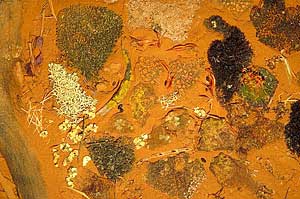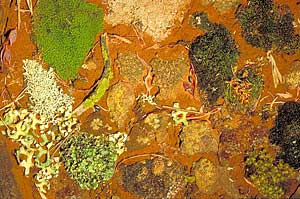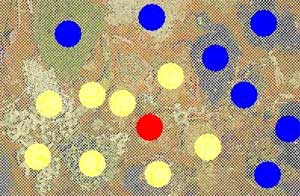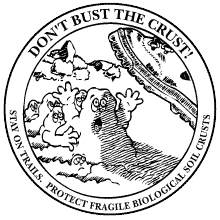 Ecology
Ecology
Biological soil crusts
In many of the world's drier areas extensive carpets of lichens, bryophytes and cyanobacteria play important ecological roles. Such carpets are called biological soil crusts and one of their major functions is erosion control. In many dry parts of the world where there is no human disturbance and no overstocking of grazing animals, biological soil crusts can form very extensive, close to continuous, carpets on the soil and can be the dominant or only photosynthesizers. Consequently such crusts are the dominant or only primary producers on which other organisms depend. Both lichens and bryophytes commonly have root-like structures (but not true roots) to anchor themselves to the soil. In lichens they are called rhizines and in bryophytes they are called rhizoids. The small book listed in the reference button gives an excellent introduction to these soil crusts, with photographs of many of the crust-forming species found in Australia![]() .
.
This scene ![]() shows a biological soil crust in which the yellowish thalli of Fulgensia cranfieldii are growing with green bryophytes and here
shows a biological soil crust in which the yellowish thalli of Fulgensia cranfieldii are growing with green bryophytes and here ![]() is a closer view. Most obvious in this photo
is a closer view. Most obvious in this photo ![]() are many pale thalli of the genus Xanthoparmelia that are growing on the ground near Renmark in South Australia and here are close views of the thalli of two soil inhabiting Xanthoparmelias - Xanthoparmelia arapilensis
are many pale thalli of the genus Xanthoparmelia that are growing on the ground near Renmark in South Australia and here are close views of the thalli of two soil inhabiting Xanthoparmelias - Xanthoparmelia arapilensis ![]() and Xanthoparmelia versicolor
and Xanthoparmelia versicolor ![]() . Psora decipiens is a cosmopolitan soil crust lichen and is found in many drier parts of Australia. The squamulose thalli are up to about a half centimetre in diameter, orange-brown when moist
. Psora decipiens is a cosmopolitan soil crust lichen and is found in many drier parts of Australia. The squamulose thalli are up to about a half centimetre in diameter, orange-brown when moist ![]() but with a somewhat hoary coating when dry
but with a somewhat hoary coating when dry ![]() . The black apothecia are up to a millimetre or so in diameter and this photo
. The black apothecia are up to a millimetre or so in diameter and this photo ![]() shows them on the margins of a number of thalli, though the dark soil and the abundant sand grains can make it hard to see them. A few other examples of soil crust lichens are Placidium squamulosum
shows them on the margins of a number of thalli, though the dark soil and the abundant sand grains can make it hard to see them. A few other examples of soil crust lichens are Placidium squamulosum ![]() the thalli of which are similar in size to those of Psora decipiens, though a little darker; Heppia despreauxii
the thalli of which are similar in size to those of Psora decipiens, though a little darker; Heppia despreauxii ![]() and species of Peltula
and species of Peltula ![]() , some with very dark thalli.
, some with very dark thalli.
In many dry areas rainfall is typically infrequent but when it does rain it may pour torrentially with tremendous force. Such a downpour, hitting bare soil, would quickly churn up the ground and erode the land. A lichen or bryophyte carpet can greatly reduce or even negate the erosive potential of a massive downpour. In the first instance the biological crust takes the brunt of the falling raindrops and absorbs much of the impact. Moreover, the biological soil crust will absorb and retain a lot of water, though in a heavy downpour much water will still spread out. However, a healthy and diverse crust gives the soil an irregularly raised and roughened surface which slows the flow of water. Those surface irregularities also mean that, in an extensive crust, there is an abundance of tiny depressions. While each depression may be quite small, a great amount of water can be trapped by an extensive crust. By slowing or trapping the flow, healthy crusts give the water more time in which to infiltrate the underlying soil and also gives any suspended soil particles a greater chance of settling out from the water. The precise rate of water infiltration into the soil in any particular area will depend on the make-up of the soil crusts in that area and the nature of the underlying soil. For example, soils with a high clay content typically have a low infiltration rate, regardless of the presence or absence of an overlying crust. Crusts that are rough and irregular, rather than flat, lead to a higher infiltration rate. That is understandable, since a rough surface provides more obstacles to water flow and more opportunities for pooling.
The following pair of photographs (which can be enlarged) show how dramatically some of the biological soil crust organisms react to water. The photographs depict an artificial set-up, in that these specimens were not all growing in the one, small area. However, they were all collected from the dry western half of New South Wales. The photo on the left shows the scene when dry and the photo on the right shows the same scene wet. The response to water was quite rapid. It took only a minute or two for the transformation.
 |
 |
The following image helps explain what is shown in the previous two photos. The yellow dots indicate lichens, the blue dots show mosses and the one liverwort is marked by a red dot.
 |
yellow = lichen blue = moss red = liverwort |
Biological crusts also protect against wind erosion since the various organisms constituting such crusts bind soil grains. Experimental studies have shown that crust-free soils are subject to erosion at much lower wind speeds than is the case when the soil has a healthy biological crust.
A good crust creates niches for a variety of tiny invertebrates. Amongst these are species which burrow into the underlying soil, so creating micro-channels through which water can penetrate into the ground. Amongst the smaller invertebrates that shelter in lichens and bryophytes are those that are essential in the decomposition and mineralization processes in arid areas. Invertebrates are eaten by other invertebrates or by vertebrate animals and so biological soil crusts are essential components of various food webs. The crusts also provide niches for seed germination. The crusts hold on to water at least a little longer than does bare soil, give the underlying soil some protection against direct sunlight and help reduce evaporative water loss from the soil. All this may not seem like much, but it can be enough to help a young seedling (with its fine roots) become established.
Many arid area lichens show photosynthesize for a few hours in the morning but typically become dry and dormant by midday. The HYDRATION AND PHOTOSYNTHESIS CASE STUDY gives some more details about the relationships between thallus water content and photosynthesis. Lichen photosynthesis generally is most efficient at lower temperatures but there are some exceptions. In the western United States Collema tenax is a major component of biological soil crusts, with erratic showers the major source of water. Algae are the photobionts found in the majority of lichens but Collema tenax has a cyanobacterial photobiont. When hydrated it has a gelatinous texture, has a high water-holding capacity and is able to photosynthesize at higher temperatures. For example, one study has shown that at 41° C net photosynthesis was still about 30% of the optimal rate whereas many lichens would have become dormant at much lower temperatures. Several other cyanobacterial lichens have also been found to well-adapted to higher temperatures. Nevertheless, in general high temperatures depress photosynthesis in hydrated thalli and crusts tend to be poorly developed in areas of high summer rainfall. Cyanobacterial lichens need liquid water for rehydration whereas lichens with algal photobionts can use fog or dew very effectively. There are several arid coastal areas where fogs are common and there's some more information about such fog deserts on the LICHENS IN ARID AREAS page. One of the well-studied fog deserts is the coastal fog zone in the Namib Desert. Studies in that region have shown that under optimal conditions of moisture and light the lichen soil crusts found there have a photosynthetic potential close to that of the leaves of vascular plants![]() .
.
 The biological soil crusts in arid areas are well-adapted to life in exposed, harsh environments but are susceptible to damage from heavy impacts. Examples of damaging actions are overstocking of livestock in arid-area grazing lands and recreational activities such as off-road driving and walking. The crusts can tolerate some damage but recovery is very slow once they have been severely damaged. Recreational activities are recognized as potential threats in some of the highly-visited national parks in the USA, hence the use of the accompanying sign in a number of arid-area parks.
The biological soil crusts in arid areas are well-adapted to life in exposed, harsh environments but are susceptible to damage from heavy impacts. Examples of damaging actions are overstocking of livestock in arid-area grazing lands and recreational activities such as off-road driving and walking. The crusts can tolerate some damage but recovery is very slow once they have been severely damaged. Recreational activities are recognized as potential threats in some of the highly-visited national parks in the USA, hence the use of the accompanying sign in a number of arid-area parks.
This excellent website, http://www.soilcrust.org, created within the US Geological Survey, provides more information and illustrations. The final reference button on this page gives some very useful general references![]() .
.
![An Australian Government Initiative [logo]](/images/austgovt_brown_90px.gif)

